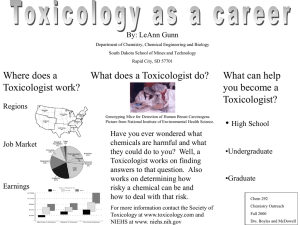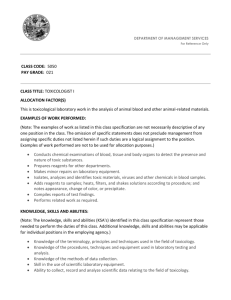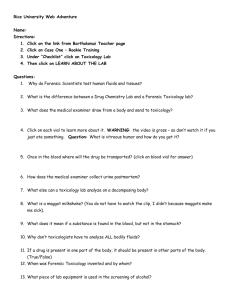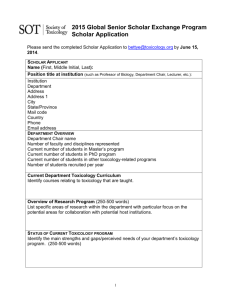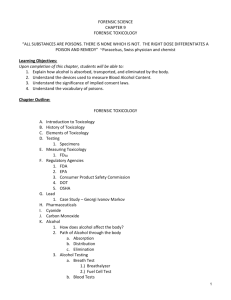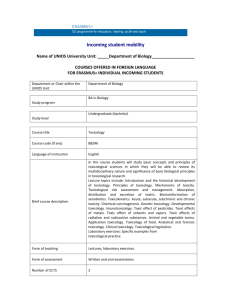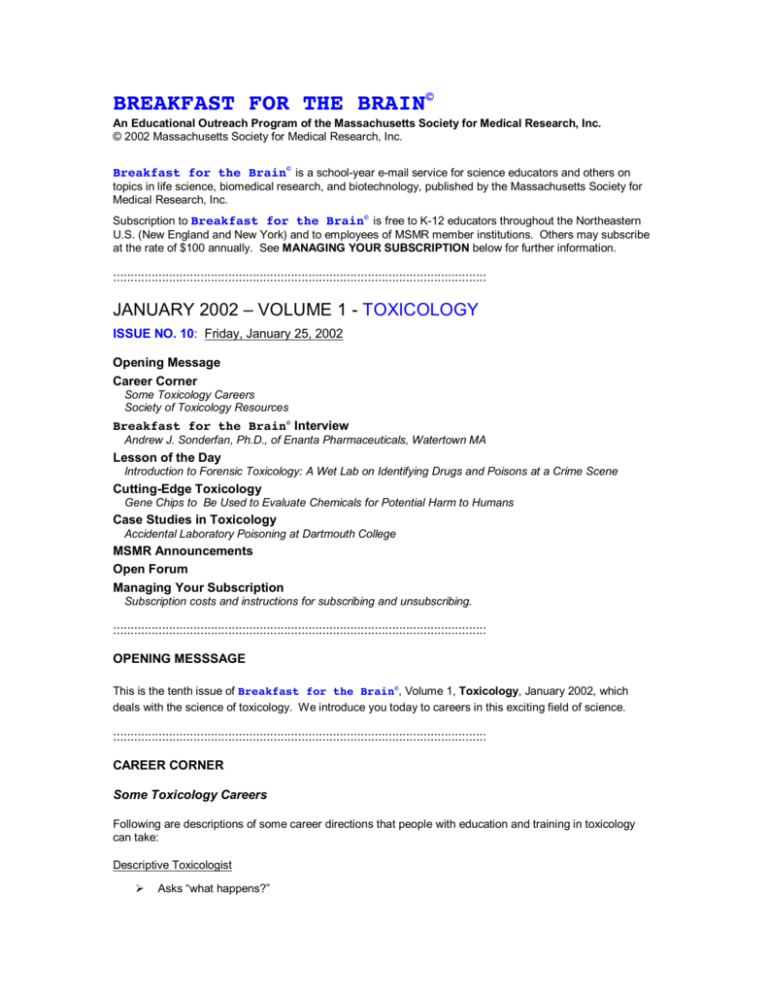
BREAKFAST FOR THE BRAIN©
An Educational Outreach Program of the Massachusetts Society for Medical Research, Inc.
© 2002 Massachusetts Society for Medical Research, Inc.
Breakfast for the Brain© is a school-year e-mail service for science educators and others on
topics in life science, biomedical research, and biotechnology, published by the Massachusetts Society for
Medical Research, Inc.
Subscription to Breakfast for the Brain© is free to K-12 educators throughout the Northeastern
U.S. (New England and New York) and to employees of MSMR member institutions. Others may subscribe
at the rate of $100 annually. See MANAGING YOUR SUBSCRIPTION below for further information.
:::::::::::::::::::::::::::::::::::::::::::::::::::::::::::::::::::::::::::::::::::::::::::::::::::::::::::
JANUARY 2002 – VOLUME 1 - TOXICOLOGY
ISSUE NO. 10: Friday, January 25, 2002
Opening Message
Career Corner
Some Toxicology Careers
Society of Toxicology Resources
Breakfast for the Brain© Interview
Andrew J. Sonderfan, Ph.D., of Enanta Pharmaceuticals, Watertown MA
Lesson of the Day
Introduction to Forensic Toxicology: A Wet Lab on Identifying Drugs and Poisons at a Crime Scene
Cutting-Edge Toxicology
Gene Chips to Be Used to Evaluate Chemicals for Potential Harm to Humans
Case Studies in Toxicology
Accidental Laboratory Poisoning at Dartmouth College
MSMR Announcements
Open Forum
Managing Your Subscription
Subscription costs and instructions for subscribing and unsubscribing.
:::::::::::::::::::::::::::::::::::::::::::::::::::::::::::::::::::::::::::::::::::::::::::::::::::::::::::
OPENING MESSSAGE
This is the tenth issue of Breakfast for the Brain©, Volume 1, Toxicology, January 2002, which
deals with the science of toxicology. We introduce you today to careers in this exciting field of science.
:::::::::::::::::::::::::::::::::::::::::::::::::::::::::::::::::::::::::::::::::::::::::::::::::::::::::::
CAREER CORNER
Some Toxicology Careers
Following are descriptions of some career directions that people with education and training in toxicology
can take:
Descriptive Toxicologist
Asks “what happens?”
Evaluates the toxicity of drugs, food additives, and other products.
Determines dose-response relationships.
Works in a contract lab, in a pharmaceutical or other industry, or in an academic setting.
Does tests involving in vitro analysis, animal testing, and/or human clinical trials.
Conducts tests as specified by government regulations.
Mechanistic Toxicologist
Asks “How?”
Works to discover a chemical’s mechanism of action using basic research techniques.
Studies biomedical research, biochemistry, physiology, etc.
Relates mechanism to finding antidotes.
Explores absorption, distribution, and excretion of a chemical.
Works in academic settings or for private industry.
Clinical Toxicologist
Begins with training as a medical doctor or veterinarian.
Explores the prevention, diagnosis, and treatment of toxicoses.
Specializes in toxicology issues concerning drugs used for treatment (side effects, overdoses),
drugs of abuse, and accidental poisonings to a degree greater than other doctors.
Environmental Toxicologist
Studies pollutant effects on organisms, populations, ecosystems, and the biosphere.
Investigates pollutants that are human-made, as well as those resulting from human activity (e.g.,
increased levels of atmospheric carbon dioxide).
Facilitates remediation.
Works in academic settings, in private industry, or for the government (Environmental Protection
Agency, Department of the Interior, etc.)
Regulatory Toxicologist
Asks questions about risk and makes decisions based on scientific data.
Strives to protect humans and animals from excessive hazards and risks.
Works for government bureaus, such as FDA (Food and Drug Administration), EPA (Environmental
Protection Agency), CPSC (Consumer Product Safety Commission), OSHA (Occupational Safety
and Health Administration), and DOT (Department of Transportation).
Involved with writing and/or enforcing laws, including SDWA (Safe Drinking Water Act), CAA (Clean
Air Act), CWA (Clean Water Act), CERCLA (Comprehensive Environmental Response,
Compensation and Liability Act – Superfund), FIFRA (Federal Insecticide, Fungicide, and
Rodenticide Act), and ToSCA (Toxic Substances Control Act).
Forensic Toxicologist
Studies and practices the application of toxicology to the purpose of law.
Performs chemical analysis of crime evidence.
Generally works for law enforcement agencies.
Teams with pathologists and law enforcement officials within the legal system (e.g., trace elements
at autopsy can give evidence as to where someone lives or works).
*********************
The Society of Toxicology publishes a career-oriented brochure for high school students entitled How About
a Career in Toxicology? It can be downloaded in PDF format from http://www.toxicology.org/
MemberServices/FormsApps/EdBroch2.pdf.
A Resource Guide to Careers in Toxicology can be found online at the Society of Toxicology Web site at
http://www.toxicology.org/MemberServices/FormsApps/EdBroch2.pdf. Includes a regional distribution of
toxicology jobs, earnings projections for toxicologists; and career preparation for toxicology.
The Society of Toxicology (SOT) also serves as a clearinghouse for student research internships in
toxicology. Sponsors submit information about available research internships to SOT, which makes a
cumulative listing available to students from January through April each year. Students apply directly to
program sponsors for internships. A flyer on SOT student research internships is available at
http://www.toxicology.org/ MemberServices/ FormsApps/INT_Info.pdf. Internship postings for 2002 can be
found at http://www.toxicology.org/publicoutreach/educationoutreach/internshippostings.html. The student
application form can be downloaded in PDF format from http://www.toxicology.org/MemberServices/
FormsApps/IntApp.rtf.
:::::::::::::::::::::::::::::::::::::::::::::::::::::::::::::::::::::::::::::::::::::::::::::::::::::::::::
Breakfast for the Brain© INTERVIEW
Andrew J. Sonderfan, Ph.D. of Enanta Pharmaceuticals, Watertown MA
Andrew Sonderfan, PhD, DABT is a member of MSMR who recently joined Enanta Pharmaceuticals in
Watertown, MA as Director of Toxicology and Safety Pharmacology. Dr. Sonderfan received his PhD in
1988 from the University of Kansas Medical Center, and was employed at Syntex Research in Palo Alto, CA
as Toxicologist and later Nonclinical Leader. While in California, Andy chaired the Public Education and
Communications Committee of the Northern California Society of Toxicology (SOT) chapter, and later was
NorCal SOT’s Treasurer. Moving to Massachusetts in 1994, Dr. Sonderfan joined Procept, and later
MacroChem Corporation, and Canada’s BioChem Pharma (now merged with Shire Pharmaceuticals Group).
He is a member of SOT and its Northeast Chapter, as well as the Safety Pharmacology Society and the
American Association for Laboratory Animal Science. At Enanta, Andy is characterizing novel compounds
under evaluation for antibacterial and immunosuppressive clinical indications. Enanta’s mission is to
accelerate drug discovery by “morphing” existing drugs, natural products, and biologically active peptide
leads into small molecules with improved pharmacological properties.
BftB©:
What is your educational background?
I received my BS in Toxicology at Philadelphia College of Pharmacy and Science in 1984. As part of my
undergraduate experience, I worked full-time for 7 months as an industrial trainee at Lederle Laboratories
(Pearl River, NY). I completed my PhD in Toxicology at the University of Kansas Medical Center in 1988,
where I studied P450-dependent steroid biotransformation in the laboratory of Dr. Andrew Parkinson.
BftB©: When did you know you wanted to be a scientist? Did you have any science or non-science
teachers that were especially influential in developing your interest in science?
I’ve always been interested in science, particularly the life sciences. My high school chemistry teacher, Mr.
Adams, seemed to be having a great time doing, and teaching, chemistry, and I enjoyed the classroom work
and especially the laboratory work in his class. I recall that, in high school, I managed to write and present a
senior Cellular Biology paper on “ribosomes” without any mention of protein synthesis. Since then, I think,
my research and preparation have become a bit more thorough.
BftB©:
What factors led you to specialize in toxicology?
Well, I enjoyed biology and chemistry, and somehow thought (wrongly, it would have turned out) that
pharmacy would be an ideal synthesis of these disciplines. So as a high school senior, I started getting
information from pharmacy schools, and one of them had a BS program in toxicology. Toxicology (I’d never
heard the word before) seemed an ideal synthesis of chemistry and biology (getting warmer), and also, not
insignificantly, the BS program in pharmacy required 5 years to complete, while toxicology was a 4-year
program.
Originally I planned to complete my BS degree and then get a “real” job. As part of an undergraduate
traineeship at Lederle Laboratories, I got the chance to do toxicology full-time, and I gained a very useful
perspective into the kinds of work I’d be able to do with my BS, and also the kinds of opportunities I’d have if
I went on and obtained my MS or PhD. So I went to graduate school.
BftB©:
What are your current research interests and how do you manage them?
My research is quite applied and goal-directed. If basic research has a polar opposite, then that’s what I’m
doing. Our group’s challenge is help characterize promising novel compounds, and then conduct the
studies needed to enable us to initiate and continue clinical testing for new medicines.
BftB©:
Describe a typical week in the professional life of Dr. Andrew Sonderfan.
During a typical week I’ll review the literature for developments, patents, and techniques that may be useful
in our work; discuss study design or interpretation issues with company colleagues or outside
collaborators (at universities and contract research organizations), and sometimes travel to attend scientific
meetings or participate in study activities. I regularly present data and conclusions at project team meetings
with scientists and managers, and we discuss the timing and direction of upcoming activities.
BftB©: What ideas do you have for classroom activities or projects that could introduce some of
your interests or research into an elementary, middle, or high school classroom?
I haven’t had much experience in this area. I’m interested in following Breakfast for the Brain© and
other MSMR outreach efforts and learning by example.
BftB©: What course work and/or degrees would you recommend for students who would like to
pursue a career similar to yours?
I’d recommend a solid undergraduate experience in the sciences – some excellent science and excellent
non-science courses. It’s unusual to choose the same major for undergraduate and graduate work – you
may not like your first choice, and your undergraduate experience, ideally, will help focus your thinking on
what you want to do next, whether it’s work or study. Take as much math and science as you can in high
school. See if you can get one or two internships or summer positions in the kind of company where you’d
like to be working. You’ll get a good sense of what the work is like, and you’ll meet people who are happy
and unhappy with their career choices – all of them will provide information that can help you with your own
decision-making.
BftB©: What changes do you hope to see in the world 20 years from now as a result of the kind of
work you are doing?
Only a very small fraction of novel compounds synthesized in the lab succeed in development and are
launched as new drugs. It’s no secret that most compounds that fail in clinical trials are dropped from
development because of toxicity. I’m hoping that we’ll continue to improve these long odds. The Enanta
culture fosters close collaboration between chemists and biologists, so I’m expecting we’ll continue to
identify potential safety issues early. This will enable our group to redirect resources toward programs with
the best likelihood for success in addressing important, unmet medical needs.
BftB©: What kind of outreach activities have you done in the past? Are you doing any outreach
currently?
I’ve enjoyed the opportunity to discuss the science and practice of toxicology with a couple of high school
classes, and also to do some lecturing to college undergraduates on the topic of “Industrial Toxicology.” I’ve
been fortunate enough to judge a couple of science fairs. For several years, I was a reader at Recording for
the Blind (reading text and describing figures from science and medical textbooks). A former employer
invited local middle-school students to shadow individual employees for “Ground-Shadow Day” (it was on
Groundhog Day – get it?), and that was fun to prepare for and to do.
BftB©:
How do you like to spend your free time?
My wife, Alison, and I enjoy hiking and travel, and are voracious readers of all kinds of books. We’ve
climbed on and off trains in all kinds of places. Our lives have changed quite a bit since the arrival of our 15month-old son, Ethan, but strangely we seem to be busier than ever. Hard to imagine, huh?
BftB©:
Thank you, Andy. And good luck to you and to Enanta Pharmaceuticals.
Thank you.
[ Dr. Sonderfan can be reached for further comment and questions by e-mail at ASonderfan@enanta.com or
by telephone at (617) 607-0723. ]
:::::::::::::::::::::::::::::::::::::::::::::::::::::::::::::::::::::::::::::::::::::::::::::::::::::::::::
LESSON OF THE DAY
Introduction to Forensic Toxicology:
A Wet Lab on Identifying Drugs and Poisons at a Crime Scene
Grade Level
High School
Lesson Objectives
The purpose of this lesson is to identify some common drugs and detect toxic metals by chemical analysis.
Upon completion of this activity, students will be able to:
1.
conduct tests on several known substances; and
2.
identify unknown drugs and poisons through the same chemical tests.
Background Information
Police detectives Starsky and Hutch of the Wentworth Police Department have just arrived at the scene of
an emergency. Emergency medical technicians are providing life support to a man discovered unconscious
in his apartment bedroom by a neighbor. The man appears to have been drugged.
The police officers begin searching the apartment for indications that the man may have ingested something
harmful. They find a white capsule ground into the bedroom carpet. One of the officers puts fragments of
the capsule carefully into a plastic bag and labels it. He will return the sample to the crime lab for a chemical
analysis.
The police officers do not assume that a crime has been committed. The man may have drugged himself.
However, it is important to know what substance was involved. That information may help doctors to treat
the patient, who is now being taken on a stretcher to the emergency van outside, or to identify a suspect if
the man was poisoned.
At the crime lab, a lab technician in the toxicology section runs a series of standard tests on the capsule the
police found. Some tests consist largely of treating the unknown substance with test reagents. The
appearance of the substance after it has been treated gives clues to its identity. Color changes after
reaction with a given substance are often telltale.
One type of test, called chromatography, can separate out various substances in a mixture. The
components of blood or urine may be separated by chromatography, for example. In this activity, students
will use paper chromatography to identify two amino acids sometimes present in the urine of a person who
has been poisoned.
Materials Needed
PART I
Toothpicks
Goggles
Lap apron
Gloves
Household ammonia, nonsudsing (NH4OH)
4x3 spot plates
Lead solution
Mercury solution
Potassium iodide
Goggles
Lab apron
Gloves
Alanine
Glycine
Ruler (15 cm)
Chromatography tubes with rubber stoppers
Developing solution (butanol/acetic acid)
250-ml disposal flask
Ninhydrin
Hair dryers or drying oven
Microcapillary pipette
No. 2 lead pencil
Wax pencil
Chromatography paper
Aspirin
Tylenol
Alka-Seltzer
Sodium bicarbonate
Distilled water
0.5M hydrochloric acid
Spatula
Ferric nitrate solution
Toothpicks
Goggles
Lab apron
Gloves
4x3 spot plates
Universal indicator (with reference chart)
PART II
PART III
Lesson Activities
PART I: Testing for Heavy Metal Poisons
Label three columns of a spot plate “Pb” (lead), “Hg” (mercury), and “U” for unknown. Label two rows with
the chemical formulas of the test reagents (KI for potassium iodide and NH4OH for ammonium hydroxide
solution).
Add two drops of lead (Pb) solution; two drops of mercury (Hg) solution; and two drops of an unknown (Por
Q) to the appropriate wells of the spot plate. Add two drops of potassium iodide solution to each well in the
appropriate row. Note changes in line A of Data Table 1. Add two drops of ammonium hydroxide solution to
each well in the appropriate row. Note changes in line B of Data Table 1.
Data Table 1: Heavy Metals
Lead
A.
Result with KI solution
B.
Result with NH4OH solution
Mercury
Unknown
KI reacts with lead as follows:
Pb(NO3)2 + 2KI ----------------
PbI2 + 2KNO2 (yellow precipitate)
NH4OH reacts with lead as follows:
NH4OH + HgNO3 --------------- NH4NO3 + HgOH (gray precipitate)
Based on these reactions, students will be able to identify their unknown heavy metal. Based on the
chromatography results, does the unknown sample indicate the victim has been poisoned with a heavy
metal?
PART II: Testing for Signs of Heavy Metal Poisoning
Handle chromatography paper with gloves on to eliminate contamination of the test paper. Write on the
paper only with light pencil. On each of three strips, draw a faint horizontal line one cm from the end. Label
the other end “Ala,” “Gly,” or “U” (unknown).
Using a microcapillary pipette, concentrate a spot of alanine solution at the center of the faint line on strip
“Ala,” a spot of glycine solution on strip “Gly,” and a spot of the unknown (R or S) on strip “U.”
With wax pencil, make a heavy line 0.5 cm from the bottom of each chromatography tube. Fill each tube
0.5-cm high with developing solution. Load each strip into a different tube with the label toward the top of
the tube. Use a rubber stopper to suspend each strip so it hangs straight and does not crimp against the
walls of the tube.
While waiting for paper to develop, begin Part III.
After the developing solution has reached close to the tops of the strips, Remove the strips and place them
on paper towels. Draw a heavy pencil line at the leading edge of the developer on each strip. Allow strips to
dry, then, working in a well-ventilated space, spray with a light mist of ninhydrin solution. Dry strips with a
hair dryer or in drying oven.
For each strip, measure the distance (in mm) from the first (faint) line you drew to the leading edge of the
stain. Record distances in Column 2 of Data Table 2. For each strip, measure the distance (in mm) from
the faint line to the heavy line. Record distances in Column 1 of Data Table 2.
Data Table 2: Heavy Metals
Tube
1.
Distance
developer
traveled (mm)
2.
Distance
stain
traveled (mm)
3.
Rf value
C. Ala - alanine
D. Gly - glycine
E.
Unknown (R or S)
Calculate Rf values for strips “Ala,” “Gly,” and “U” according to the following formula:
Rf = Distance stain traveled / Distance developer traveled
Record these values in Column 3 of Data Table 2.
PART III: Testing for Over-the-Counter Drugs
Label the spot plate (or a diagram of it) as follows: Above each column, write an abbreviation for one of the
over-the-counter (OTC) drugs provided. Beside each row, write an abbreviation for one of the test reagents
(universal indicator, hydrochloric acid, and ferric nitrate solution).
Fill wells with the appropriate substance. In Row F of Date Table 3, indicate the appearance of each drug.
Add 5 drops of distilled water to each well of the spot plate. Note any changes in Row G of Data Table 3.
To each well in the first row of the spot plate, add one drop of the universal indicator. Use a different
toothpick to gently mix the contents of each well.
In Row H of Data Table 3, record the pH of each substance according to the reference chart provided with
the universal indicator (or see Reference Table below).
Reference Table
_____________________________________________________
Color After Adding Universal Indicator
pH
_____________________________________________________
Orange-red
2
Red-orange
3
Orange
4
Yellow-orange
5
Orange-yellow
6
Green-yellow
7
Green
8
Green-blue
9
Blue-violet
9.5
Violet
10
Violet-red
11-12
_____________________________________________________
To each well in the second row of the spot plate, add two drops of hydrochloric acid solution. Note any
change in Row I of Data Table 3.
To each well in the third row, add two drops of ferric nitrate solution. Use a different toothpick to gently mix
the contents of each well and record the color of each in Row J of Data Table 3.
Set the spot plate aside. Label the columns of another spot plate with letters (either X, Y, or Z) for the
unknown substance. Label the rows with the names of the same test reagents. Repeat the procedure.
Data Table 3: Over-the-Counter Drugs
Known Drugs
Aspirin
Tylenol
Sodium Bicarbonate
Unknown
Other
(X, Y or Z)
G. Appearance before
testing
H. Changes after water
added (if any)
I.
pH
J.
Reaction with HCl
(if any)
K.
Color after testing with
ferric nitrate
Which OTC substances in Data Table 3 showed bubbling when tested with HCl? Which gas produced the
bubbles? [Hint: If you can write a chemical equation for this reaction, one of the reaction’s products will be
your answer.] Identify the unknown OTC drug.
Source: Adapted from Applications in Biology/Chemistry: Disease and Wellness, Center for
Occupational Research and Development, Waco TX, 1999.
:::::::::::::::::::::::::::::::::::::::::::::::::::::::::::::::::::::::::::::::::::::::::::::::::::::::::::
CUTTING-EDGE TOXICOLOGY
Gene Chips to Be Used to Evaluate Chemicals for Potential Harm to Humans
The National Institute of Environmental Health Sciences (NIEHS) announced recently that it has created a
half-million-dollar center at its laboratories in North Carolina to help evaluate the toxicity of chemicals by
observing how they turn "on" or "off" thousands of different cloned genes clustered on a laboratory slide.
The changes in gene expression caused by the chemicals are read and displayed by computer, showing up
as dots of color on the computer's screen. Potentially, the new NIEHS Microarray Center could provide
safety information better and faster than do animal tests -- and would replace, augment or improve on many
of them.
“We're very bullish on the center's potential to revolutionize the screening of chemicals," NIEHS Director
Kenneth Olden said in announcing the center.
The new NIEHS Microarray Center makes use of the ToxChip, developed at NIEHS, which contains copies,
or clones, of about 2,000 of the 80,000 genes in the human body. Millions of cloned copies of each gene
form a nearly invisible dot that is "arrayed" -- hence the name -- in a grid pattern on the glass slide. The
center also uses an even newer microarray, called the Human ToxChip, containing clusters of each of
12,000 different cloned genes.
Toxic substances produce changes that express, or turn on and off, genes, the center scientists said, and
the chips and the accompanying computer support used to read the slides, take advantage of that linkage.
Initially the new center is evaluating known toxins – for example, chemicals that are known to cause cancer
and/or mutations - to build a library or database showing the typical genetic changes that these known
poisons produce. Once they have "signature" profiles of how known toxins change genes, the scientists
said, they can evaluate other chemicals for potential harm by comparing the gene changes they produce
with those made by the known toxins.
A match between an expression signature or "on/off" pattern produced by an unknown compound and that
from an established toxic compound would indicate a potential danger in the test compound.
NIEHS Director Olden said, "There are thousands of both natural and man-made chemicals in human use
and commerce that have never been adequately tested. We are developing a technology that will greatly
aid in their evaluation and identification. The idea is simple: If ToxChip screening shows that a test chemical
changes key gene expressions in the same way as a known toxin does, there's a strong likelihood the test
chemical may be harmful too."
In addition to creating the new microarray center in its laboratories at Research Triangle Park, N.C., NIEHS
is developing plans to help other organizations – including some of its 20 university-based environmental
health centers - establish microarray capabilities and skills. Already, visiting scientists, including several
from abroad, have worked alongside the center's 12 scientists.
Although developing a microarray capability currently may require start-up costs of $500,000, the screening
tests traditionally carried out on mice and rats require more than two years and can cost $2.5 million per
substance. As a result, only about 10 of the most commonly used chemicals can be screened each year by
the National Toxicology Program, which is also headquartered at NIEHS' facilities in Research Triangle
Park, the locale of high tech government labs and businesses between Raleigh, Durham and Chapel Hill,
N.C.
NIEHS Microarray Center Co-Director Cynthia Afshari, Ph.D., said that before mass chemical screening is
carried out, the work promises to unlock some of the secrets of how our environment changes our genes.
"From a public health standpoint, knowing how the environment changes our genes may be as important as
knowing the functions of the genes themselves," Dr. Afshari said, "because we often can do something
effective to change the environment or substitute one chemical for another in industry, whereas in most
cases we cannot alter our genetic or cellular response to these agents."
The ToxChip was developed by NIEHS Scientific Director J. Carl Barrett, Ph.D., Dr. Afshari, and
postdoctoral fellow Emile F. Nuwaysir, at NIEHS in Research Triangle Park, N.C. Jeff Trent, Ph.D., and
Michael Bittner, Ph.D., pioneers in microarray studies at the National Human Genome Research Institute in
Bethesda, Md., helped NIEHS in the development of its toxicology-focused center.
Scientists using the ToxChip also see a potential for it to speed drug research by accelerating the safety
tests that are necessary before testing potential new drugs in people.
In the original ToxChip, the genes used are cloned duplicates of the genes of humans. The team has also
developed additional microarrays using cloned genes from common test animals and organisms -- mice,
rats, frog (xenopus) and yeast. "We are making profiles of known toxins using several or all of these
species' genes," Center Co-Director Richard S. Paules, Ph.D., said.
If you looked carefully at a glass slide that has been turned into a ToxChip, you would see a grid of dots,
each looking like a bit of dust. Each dot is a cluster of millions of cloned copies of a single gene and is
precisely placed in a grid by a robot.
When genes are expressed, or turned on or off, gene messengers - a template or mirror image of the DNA
is made called messenger RNA to carry out the DNA's will. These can be marked to appear either red or
green when lasers are shined on them. These RNA molecules search for and connect with their DNA match
on the slide and are read by a scanner as a red or green dot.
Changes in the red and green dots following exposures to test chemicals and to known poisons are read
and compared using computers - a process similar to reading two scanner codes on a supermarket
purchase but then comparing them, rather than adding them up.
When these match up - when, say, there is a similarity in the pattern of green or red spots, there will be a
good chance the new substance is also a poison, or toxin, and should be studied further.
The Internet site for the center, where additional information is available, is
http://dir.niehs.nih.gov/microarray. Pictures are available at http://www.niehs.nih.gov/oc/news/toxchips.htm.
:::::::::::::::::::::::::::::::::::::::::::::::::::::::::::::::::::::::::::::::::::::::::::::::::::::::::::
CASE STUDIES IN TOXICOLOGY
Accidental Laboratory Poisoning at Dartmouth College
In the spring of 1997, the science community was saddened to learn of the tragic death of Karen E.
Wetterhahn, age 48, a professor of chemistry at Dartmouth College and a noted researcher on the effects of
heavy metals in biological systems. Wetterhahn died of dimethylmercury poisoning as the result of the
accidental spillage of a few drops of the chemical on her latex glove-covered hand in the course of
calibrating a nuclear magnetic resonance (NMR) apparatus with the standard dimethylmercury.
The accident occurred on August 14, 1996, and the poisoning produced progressive destruction of
Wetterhahn's nervous system, until she finally died 10 months later. Before she lapsed into a vegetative
state, Karen Wetterhahn requested that her case be presented to the general medical community, to
scientists working with mercury, and to toxicologists, in the hope of improving the recognition, treatment, and
prevention of future cases of mercury poisoning. The full medical case report of the illness, death, and
autopsy of Karen E. Wetterhahn was published a year later. Nierenberg et al, the authors of the report,
make the following points:
Dimethylmercury is lethal at a dose of approximately 400 mg of mercury (equivalent to a
few drops, or approximately 5 mg per kilogram of body weight). It is classified as a
"supertoxic" chemical.
Records suggest that Wetterhahn handled dimethylmercury on only one day, while
wearing latex gloves and working under a ventilated hood designed to prevent exposure
to chemical fumes. She had delayed but ultimately fatal neurotoxic effects similar to those
caused by methylmercury compounds, and this case illustrates the potent toxicity of
dimethylmercury and the need for additional safety precautions if it is to be used in any
scientific research.
Five months after the accident, on January 20, 1997, Wetterhahn was admitted to the
university medical center with a 5-day history of progressive deterioration in balance, gait,
and speech. She had lost 15 lb over a period of 2 months, and had experienced several
brief episodes of nausea, diarrhea, and abdominal discomfort.
Wetterhahn recalled that in August 1996, while transferring liquid dimethylmercury from a
container to a capillary tube, she spilled several drops from the tip of the pipette onto the
back of her gloved hand. She reported that she had cleaned up the spill and then removed
the protective gloves. (The date of the accident was established from her notebooks and
other laboratory data to be August 14, 1996.)
On February 6th, 22 days after the first neurologic symptoms developed (and 176 days
after exposure), Wetterhahn became unresponsive to all visual, verbal, and light-touch
stimuli.
The authors report they could find only 3 previously reported cases of poisoning with
dimethylmercury, all of which were fatal, and that equally bleak outcomes had been
reported in patients with severe methylmercury poisoning. In view of the dismal prognosis,
and after more than 3 months of aggressive treatment and support, Wetterhahn's advance
directives were followed, and she died peacefully on June 8, 1998, 298 days after
exposure.
Some anatomical findings from the autopsy report: "The cortex of the cerebral
hemispheres was diffusely thinned, to 3 mm. The visual cortex around the calcarine
fissure was grossly gliotic, as was the superior surface of the superior temporal gyri. The
cerebellum showed diffuse atrophy of both vermal and hemispheric folia. Microscopical
study showed extensive neuronal loss and gliosis bilaterally within the primary visual and
auditory cortices, with milder loss of neurons and gliosis in the motor and sensory cortices.
There was widespread loss of cerebellar granular-cell neurons, Purkinje cells, and basketcell neurons, with evidence of loss of parallel fibers in the molecular layer... An extensive
high mercury content was found in the frontal lobe and visual cortex, liver, and kidney
cortex. The mercury content of the brain was approximately 6 times that of whole blood at
the time of death... “
The authors conclude: "Dimethylmercury appears to be so dangerous that scientists should use less toxic
mercury compounds whenever possible. Since dimethylmercury is a "supertoxic" chemical that can quickly
permeate common latex gloves and form a toxic vapor after a spill, its synthesis, transportation, and use by
scientists should be kept to a minimum, and it should be handled only with extreme caution and with the use
of rigorous protective measures."
As a result of this accident and the subsequent scientific investigation, the chemical community has called
for the establishment of an NMR standard safer than dimethylmercury.
References: David W. Nierenberg, Dartmouth-Hitchcock Medical Center, Hinman Box 7506, Lebanon, NH
03756 US. New England J. Med. 4 Jun 98 338:1672 – and - Science-Week 26 Jun 98.
:::::::::::::::::::::::::::::::::::::::::::::::::::::::::::::::::::::::::::::::::::::::::::::::::::::::::::
MSMR ANNOUNCEMENTS
The MSMR offers a full-range of programs and materials to classroom educators on topics in biomedical
science, biotechnology, and the use of animals in research and testing. Most of the MSMR's outreach
programs and materials are available free of charge to K-12 educators throughout the Northeast (New
England and New York). To request a copy of the MSMR's catalogue of programs and materials, send an email request to Leslie Nader, Ph.D., Vice President for Education, at lnader@concentric.net.
:::::::::::::::::::::::::::::::::::::::::::::::::::::::::::::::::::::::::::::::::::::::::::::::::::::::::::
OPEN FORUM
Contribute! Send comments, questions, interesting Web sites, lesson plans, or articles that you would like to
share with other educators to Leslie Nader, Ph.D., Editor, Breakfast for the Brain©, at
lnader@concentric.net. Subscriber feedback will be included through the Open Forum section of
Breakfast for the Brain©, as well as guest articles, and other venues.
:::::::::::::::::::::::::::::::::::::::::::::::::::::::::::::::::::::::::::::::::::::::::::::::::::::::::::
MANAGING YOUR SUBSCRIPTION
Subscription to Breakfast for the Brain© is free to K-12 educators throughout the Northeastern U.S.
(New England and New York) and to employees of MSMR member institutions. Others may subscribe at
the rate of $100 annually; rate is subject to change without notice. Back issues are available to all
subscribers at a cost of $25/set of monthly issues.
To subscribe to Breakfast for the Brain©, send an e-mail request to Leslie Nader, Ph.D., Vice
President for Education, Massachusetts Society for Medical Research, Inc. at lnader@concentric.net. We
heartily welcome new subscribers and ask you to forward this message to any colleagues who might be
interested. For paying subscribers, payment must be received prior to commencement of subscriptions.
To unsubscribe, send an e-mail request to lnader@concentric.net.
:::::::::::::::::::::::::::::::::::::::::::::::::::::::::::::::::::::::::::::::::::::::::::::::::::::::::::
Look for the next issue of Breakfast for the Brain©, Volume 1 - Toxicology, next week, in which we
will turn our attention to risk perception and risk assessment.
:::::::::::::::::::::::::::::::::::::::::::::::::::::::::::::::::::::::::::::::::::::::::::::::::::::::::::
© 2002 Massachusetts Society for Medical Research, Inc. All rights reserved.
No portion of this newsletter may be republished in any form without written permission from the MSMR.
Send formal permission requests to lnader@concentric.net.
:::::::::::::::::::::::::::::::::::::::::::::::::::::::::::::::::::::::::::::::::::::::::::::::::::::::::::
Leslie Nader, Ph.D.
Vice President for Education
Massachusetts Society for Medical Research, Inc.
73 Princeton Street, Suite 311
North Chelmsford MA 01863
Tel. 978.251.1556
FAX 978.251.7683
e-mail: lnader@concentric.net




